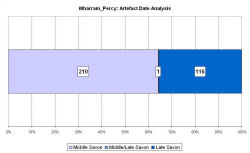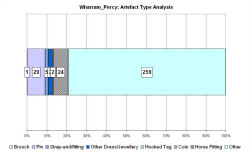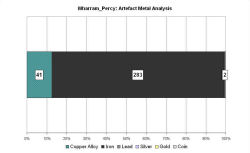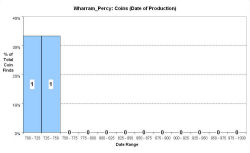Fingerprint charts for i) artefact date analysis, ii) artefact type analysis, iii) artefact metal analysis and iv) coins – date of production




References: Hurst 1984; Mays et al. 2007;
Milne and Richards 1992; Stamper and Croft 2000
Archives:
http://ads.ahds.ac.uk/catalogue/search/fr.cfm?rcn=EHNMR-636234
The deserted medieval village at Wharram Percy is located near the north-west scarp of the Yorkshire Wolds, c. 10km south-east of Malton. Long-term excavations ran from 1953 to 1990 on sites around the village. Middle Saxon remains have been found, especially at the South Manor (sites 44, 58, 81, 76 84, 85, 90) and other locations on the plateau (sites 39, 60, 94/95). The VASLE dataset is derived from Milne and Richards (1992) and Stamper and Croft (2000).
Excavations at site 39 in 1975-6 revealed a two-post SFB beneath the northern boundary bank of the village. The SFB had been backfilled with Middle Saxon midden debris, although the presence of a sceatta (AD 737-c. 758) and Tating ware pottery implied that backfilling could not have taken place until the second half of the 8th century (Milne and Richards 1992).
Sites 94/95 were excavated in 1989-90 and also revealed an SFB cut into a prehistoric boundary ditch. The SFB contained a hearth and the backfill contained metalworking debris from casting non-ferrous objects of the 8th or early 9th centuries. An infant burial and sheep found nearby were radiocarbon dated to the 8th century (Milne and Richards 1992).
A third SFB was excavated at site 60, cut into a Romano-British trackway. This was originally dated to the 6th century, but might also have continued in use until the Middle Saxon period.
Excavations on the site of the South Manor ran from 1977-78 and 1981-90, over an area of 550m². Middle Saxon finds included a number of boundaries, a post-built hall building, and a large number of finds, including local pottery, imported northern French and Ipswich Wares, and lava querns. A probable smithing area was also excavated and two sword pommels and a hilt guard may imply that the smithy dealt with weaponry as well as domestic equipment (Stamper and Croft 2000).
Richards has interpreted Middle Saxon Wharram as a relatively high-status settlement with wide-ranging contacts. He has argued (1999a) that if the site had been ploughed and metal-detected the density of finds would place it within the so-called 'productive site' category. Several finds of stone sculpture from various parts of the site mean that a monastic function should also not be discounted, although on current evidence it is wisest to interpret the site as a settlement with a high-status component.
Settlement at Wharram continued into the Anglo-Scandinavian period, which is most probably when the village was first laid out and the church established. The graves of the founder burials of the first Anglo-Scandinavian lords have been found adjacent to the first church in the valley, marked by reused Roman sarcophagi lids (Mays et al. 2007).
Fingerprint charts for i) artefact date analysis, ii) artefact type analysis, iii) artefact metal analysis and iv) coins – date of production




© Internet Archaeology/Author(s)
URL: http://intarch.ac.uk/journal/issue25/2/4.4.63.html
Last updated: Tues Apr 21 2009